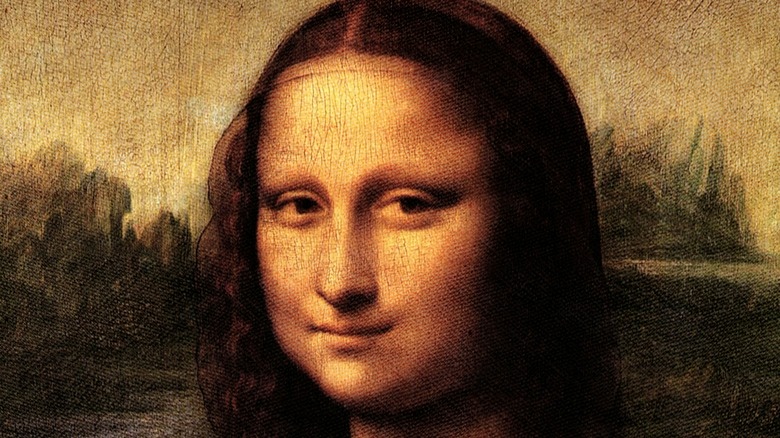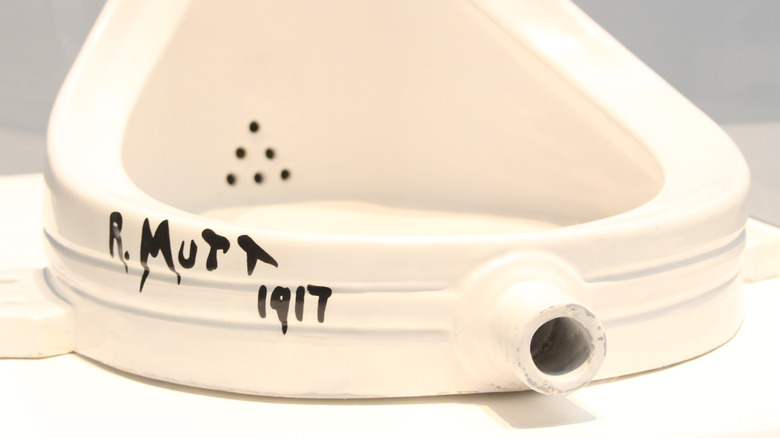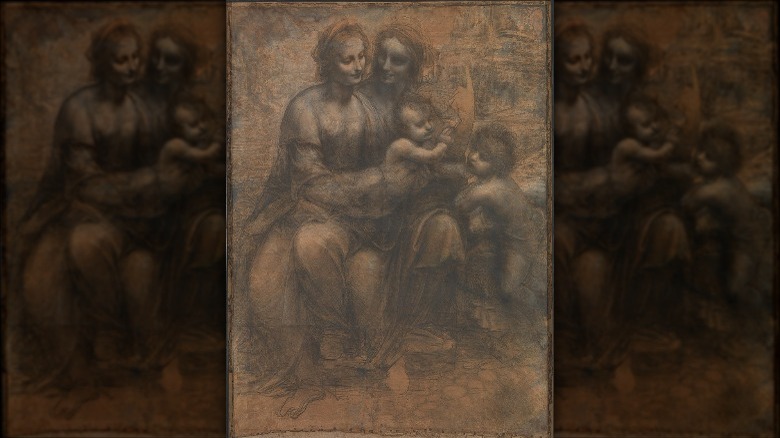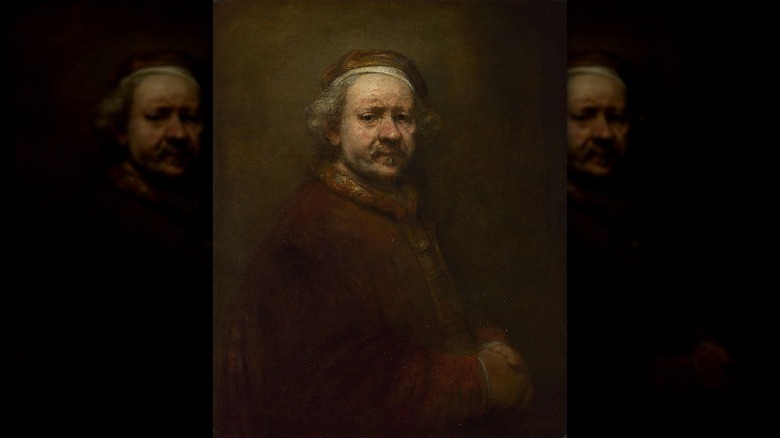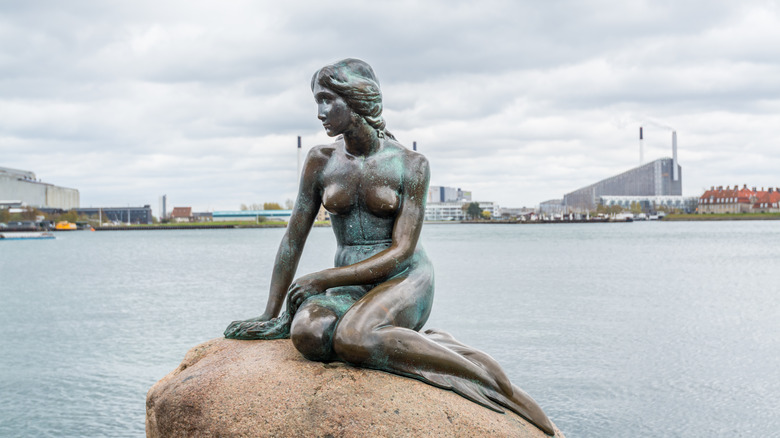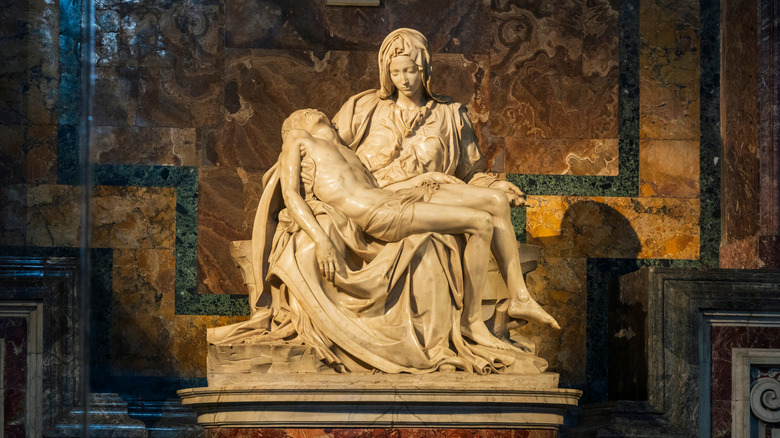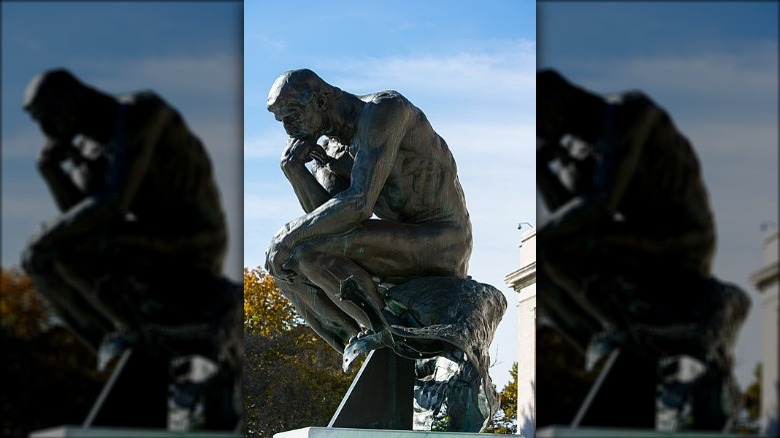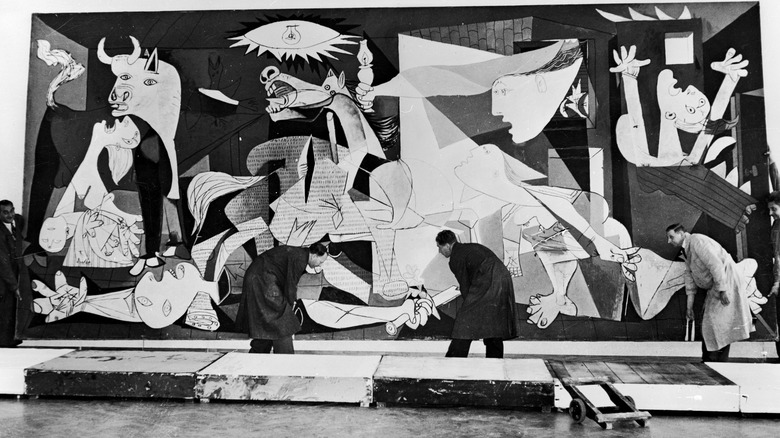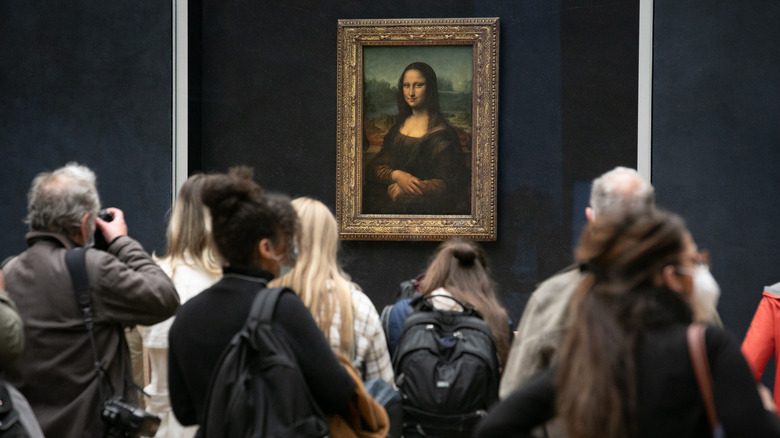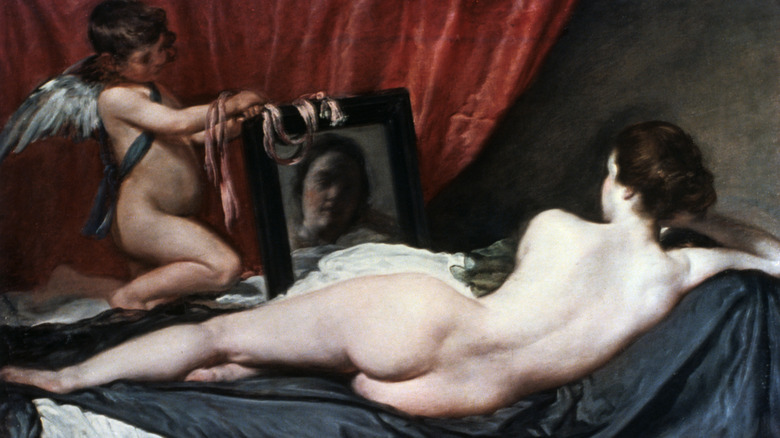Famous Works Of Art Vandalized Over The Years
On October 14, 2022, two activists from the climate change group Just Stop Oil entered the National Gallery in London with a target in mind: van Gogh's famous painting "Sunflowers." As reported in The Guardian, the pair, aged 21 and 20, approached the painting and took out two concealed tins of tomato soup, which they opened before proceeding to hurl the contents all over the Dutch masterwork. They then glued themselves to the wall and asked "What is worth more, art or life?" They were taken into police custody, while the painting, which was protected by glass, was revealed to be undamaged.
The stunt polarized opinion across the world. In fact, there hasn't been such widespread news coverage and social media debate over the fate of a painting since perhaps 2012, when a Spanish fresco of Jesus Christ titled "Ecce Homo" ("Behold the Man") by the painter Elias Garcia Martinez was badly damaged by an amateur painter, who, seeing that the work was slightly worse for wear, took a brush to it to attempt her own restoration (via the BBC). As The Guardian notes, reports of the botched restoration became instant meme fodder, with the painting renamed "Monkey Christ" by amused internet commentators.
But whether the aims are noble, misguided, or downright malevolent, art vandalism is not a new phenomenon. Here are more shocking examples of attacks on works of art.
Marcel Duchamp's Fountain
Perhaps the most notorious work of the acclaimed dada conceptualist Marcel Duchamp, "Fountain" is a piece of found art — in this case, a urinal — which the artist has upended and signed with the name of a fictional sculptor, "R. Mutt." According to the UK art institution Tate, the work caused such a stir in 1917 that the show for which it was submitted refused to display it.
Though the original version of the sculpture has long been lost, Duchamp did personally oversee the commissioning of a small number of reproductions, which have since become centerpieces of prestigious galleries around the world. And just as Duchamp's celebrated work outraged art critics at the time of its presentation, artists since have attempted to maintain the drama of the piece and undo its institutionalization as a piece of canonical art in several ways. In the 1990s for example, there was something of a vogue for artists attempting to revert "Fountain" back to its original use — i.e., as a urinal — a feat that was achieved numerous times, including by the experimental pop musician and producer Brian Eno, according to his own memoirs.
But the most famous attack on "Fountain" came in 2006, when the conceptual artist Pierre Pinoncelli was arrested for striking the installation — which at the time was valued at 3 million euros ($3.8 million), per the BBC — with a hammer, causing a chip in the porcelain, according to The New York Times. Per the same source, Pinocelli claimed at the time that the stunt was in the spirit of Duchamp and the dada art movement.
Piet Mondrian's Composition in Red, White and Blue
The value of Dutch painter Piet Mondrian's geometric paintings — which are some of the most recognizable abstract works in the world — may not be easily discernible to those of us outside academic art circles. Undoubtedly, though, their ubiquity and influence on generations of artists since they were painted in the early decades of the 20th century speak volumes for their aesthetic achievements. At the same time, the colors are nice, the shapes are pleasant enough; they could easily hang in most people's living rooms. Surely this isn't art that many would take issue with?
Step forward Jubal Brown, who in 1996 as a young art student found Mondrian's work so offensive that he vomited all over it, according to The New York Times. Originally, staff at New York's Museum of Modern Art believed it was an accident, describing the defacement as an "unfortunate incident."
However, it was later revealed (also via The New York Times) that Brown had purposefully ingested copious amounts of blue Jell-O, blueberry yogurt, and cake icing to make an especially colorful liquid jet emerge from his gullet, in protest against what he described as Mondrian's "oppressively trite and painfully banal" work. It turned out the attack was the second Brown had committed against a painting, and that he was planning a third, to complete his "triptych."
The Bamiyan Buddhas
Not all acts of cultural vandalism against art occur in a traditional gallery. In 2001, six months before the September 11 terror attacks that triggered the "War on Terror" in the Middle East and the two-decade-long suppression of the Taliban in Afghanistan, the Islamist fundamentalist group was engaged in a program of stripping the country of cultural relics and works of art that were out of step with their religious worldview.
As reported in The Guardian at the time, one of the Taliban's targets was a pair of ancient statues known as the Bamiyan Buddhas, ancient Buddhist relics that had been carved almost two millennia ago and which had stood in Afghanistan ever since. In recent decades, they had become a major tourist attraction. The Middle East Institute in Washington, D.C., has described the targeting of the statues — which each stood more than 50 feet high — as a "jihad," and characterized their destruction as an attack on the country's own "cultural heritage."
Salvador Dalí's Christ of St. John of the Cross
Salvador Dali is perhaps one of the most controversial and divisive artists of the 20th century, who, at the same time as creating some of the most challenging art around, outraged respectable society with his choice of subject matter and his bizarre behavior in real life. Best known for his surrealist work in the early part of his career, it was his later, more traditional paintings that arguably stirred the most controversy.
As noted in the L.A. Review of Books, in the post-war years, Dali returned to Renaissance-inspired portrayals of the human form and of religious imagery, both of which feature in "Christ of Saint John of the Cross." While representing Dali's public conversion to Catholicism, they also channeled something darker: his growing attraction to fascism, particularly the Spanish strain spearheaded by General Franco.
Per the same source, the $60 million painting in question is known for provoking violent responses, and has been attacked twice: once in 1961 when a young man attacked the feet of the Christ figure with a stone, and again in the early 1980s, when it was shot with an air rifle. As with most valuable works hanging in a public place, it was protected by glass.
Leonardo da Vinci's The Virgin and Child with St. Anne and St. John the Baptist
The work of supremo Italian Renaissance man Leonardo da Vinci is among the most valuable and beloved in the world, with millions of gallery visitors seeking out his creations on display around the globe and countless academics continuing to debate the merits of the 16th-century artistic and scientific genius' work. From the scrawls in his notebooks to his drafts and his complete works, every detail of his oeuvre has been pored over to unlock his mind and art.
But even the work of one as revered as da Vinci has been the target of attacks. As UPI reports, "The Virgin and Child with St. Anne and St. John the Baptist," also known as the "Burlington House Cartoon" – one of da Vinci's most visceral sketches — was badly damaged in 1987, when a man walked into the National Gallery in London, pulled out a hidden sawed-off shotgun, and took aim at the artwork. Somehow, the work was mostly restored the following year, per The New York Times.
Rembrandt's Self Portrait at the Age of 63
Onlookers at London's National Gallery were baffled on August 4, 1998, when a young man suddenly stripped stark naked and attacked an iconic Rembrandt with a tube of yellow paint, daubing the painting, his late masterwork "Self Portrait at the Age of 63" from 1669, with the symbol of the British pound sterling (£) (via The New Yorker).
A contemporaneous report claimed that the motive was unknown, but details soon emerged concerning the protest that 26-year-old fine art student Vincent Bethell was attempting to make with the stunt. "Society is mentally ill! Destroy society, long live humanity!" Bethell is said to have cried, according to The New Yorker, before he was tackled by security.
But though Bethell's sloganeering was vague, the result he was after was rather specific. Per The Guardian, Bethell was a nudism activist, and his attack on Rembrandt was intended to bring about a change in British law to make public nudity legal. The New Yorker, however, argues that Bethell's vandalism was ill-conceived. Thankfully, the painting was easily repaired.
Edvard Eriksen's The Little Mermaid
Visitors to the Langelinie promenade in Copenhagen, Denmark, have been treated to the charming sight of "The Little Mermaid," a bronze statue depicting the character from the classic Hans Christian Andersen fairy tale, for more than a century, and indeed it stands today as one of the city's most famous tourist attractions.
However, Edvard Eriksen's timeless sculpture hasn't always elicited the warm reception most tourists afford it. As the University of Copenhagen's Finn Hauberg Mortensen describes in the journal Scandinavian Studies, "The Little Mermaid" has long been a target of vandalism, starting in the 1960s, when its hair was painted red and the statue was given a set of provocative underwear. Further attacks with red paint ensued, but the most notorious resulted in the statue's decapitation, an act of vandalism that was claimed by the situationist artist Jørgen Nash.
While the statue has been defaced for various reasons over the years — most recently by anti-whaling activists in 2017 (via The Telegraph) — Mortensen claims that the statue attracts the most antipathy from vandals as a symbol of the "Disneyfication" of Danish culture.
Michelangelo's Pieta
While many acts of artistic vandalism — such as Jørgen Nash's decapitation of "The Little Mermaid" — are underpinned by aesthetic, artistic, or sociological motivations, other attacks down the years have been committed by people suffering from disturbing delusions.
In 1972, for example, a work by the Renaissance master Michelangelo titled "Pieta," a stunning statue of Jesus in the arms of his mother Mary that stands in the Vatican — and, incidentally, the only work that Michelangelo ever signed — was attacked by 33-year-old Hungarian-Australian Laszlo Toth, who struck the statue with a hammer while declaring himself an incarnation of the Messiah (via The Guardian).
"I am Jesus Christ, risen from the dead," Toth was said to have cried as he carried out the attack. Toth escaped prosecution, but was made to spend two years receiving treatment for his mental health before being deported from Italy.
Auguste Rodin's The Thinker
"The Thinker" is another one of those works of art that seems to have taken on a life of its own; it's one of the most famous statues in the world, but likely, more people know it from parodies and allusions in popular culture than they do as an actual work in itself.
So it may come as a surprise to learn that one of the handful of casts of the famous 1904 work by French sculptor Auguste Rodin was seriously damaged in a terror attack, and remains unrestored to this day. "The Thinker" has stood proudly outside the Cleveland Museum of Art since 1917, but in March 1970, the statue was the target of a pipe bombing that tore through the legs of the figure, destroying them forever (via the Cleveland Public Library).
Though a reproduction of the work could have been recast from the original molds, the Cleveland Museum of Art team decided to reinstall the damaged work without restoration, partly for fear of undermining Rodin's original work and partly as a testament to the political unrest of the 1970s. To this day, no one has been charged with the attack, though several political groups have been suspected over the years. The museum continues to share information with the FBI in the hope they can identify the perpetrators (via Cleveland.com).
Pablo Picasso's Guernica
Pablo Picasso produced many great works over the course of his long and varied career, with many entering popular consciousness as definitive artifacts of the horrors and upheavals of the first half of the 20th century. Few, however, have matched the impact of "Guernica," his immense 1937 painting critiquing the futility of war and the immense suffering that results from it. Today, "Guernica" hangs in Madrid's Museo Nacional Centro de Arte Reina Sofía, where visitors greet it was a sense of hushed awe.
However, that hasn't always been the case. In 1974, while it was on display at New York's Museum of Modern Art, the huge canvas was targeted by a young man named Tony Shafrazi, who sprayed the words "KILL LIES ALL" across the great work before being arrested (via The New York Times). As the painting was protected by a coat of varnish, the slogan was removed within an hour.
"Call the curator, I'm an artist," Shafrazi is said to have stated at the time. He is also reported to have spelled his name for people on the scene, suggesting that the attack was little more than a publicity stunt to raise his own profile. In the end, it seems to have worked: Today, Shafrazi is a famous New York art dealer who has been profiled in numerous media outlets, including People magazine.
Roy Lichtenstein's Nude in Mirror
Roy Lichtenstein's comic-book-inspired paintings and prints stand alongside the work of fellow American great Andy Warhol as quintessential pieces of 1960s pop art, and searing examples of work that questions the value of art in the age of mechanical reproduction.
Fittingly, the motivation for an attack on Lichtenstein's "Nude in Mirror" was reportedly derived from concerns over the work's authenticity. According to Graham Bader's "Hall of Mirrors: Roy Lichtenstein and the Face of Painting in the 1960s," in 2005 the work was slashed as it hung on display at an Austrian gallery. Its attacker, who was schizophrenic and armed with a knife and screwdriver, targeted it under the misguided belief that the gallery was deceiving the public by showing a copy rather than the genuine article.
The painting was restored and later listed at auction with a value of $20 million, with the attack apparently adding to the mystique of the work (via Artnet).
Leonardo da Vinci's Mona Lisa
The many mysteries around Leonardo da Vinci's "Mona Lisa" — the exact identity of the woman depicted, whether she is smiling or not, why exactly the painting has captivated viewers for centuries — has propelled the 16th century portrait to become almost unarguably the world's most famous work of art. And, as such, the priceless piece has also been the target of a great number of potential acts of vandalism to go with it.
Most recently, da Vinci's masterpiece, which is protected by bulletproof glass, was targeted by climate change protestors who attempted to smear the "Mona Lisa" with cake, according to ARTnews, with the attacker emphatically declaring in French: "There are people who are destroying the Earth ... All artists, think about the Earth. That's why I did this. Think of the planet."
The same outlet reports that the work has previously been attacked with projectiles including a stone and a teacup, and that the "Mona Lisa" was even stolen once, way back in 1911. Somehow, it survives.
Diego Velázquez's The Rokeby Venus
Politically motivated attacks against works of art are nothing new, and while many recent attacks have been the subject of derision by online commentators, historically, acts of artistic vandalism have proven to be effective means of affecting change, with notable results.
Back in 1914, a woman named Mary Richardson attacked a painting titled "The Rokeby Venus," a 17th century Baroque work by the Spanish master Diego Velázquez, while it was on display in London's National Gallery. As the academic Rowena Fowler notes in the Journal of Women's History, far from being an act of mindless vandalism, the attack was part of an orchestrated campaign by the British suffragette movement, to draw attention to the country's lack of women's right and to pressure men in power to allow women to vote in elections.
The attack on "The Rokeby Venus" was just one of 14 acts of art vandalism performed by suffragettes in 1914, with the women involved being arrested and imprisoned as a result. Though the suffragette movement ceased militant activism with the outbreak of the First World War later that year, their campaign was ultimately successful, and British women won the vote in 1928.
